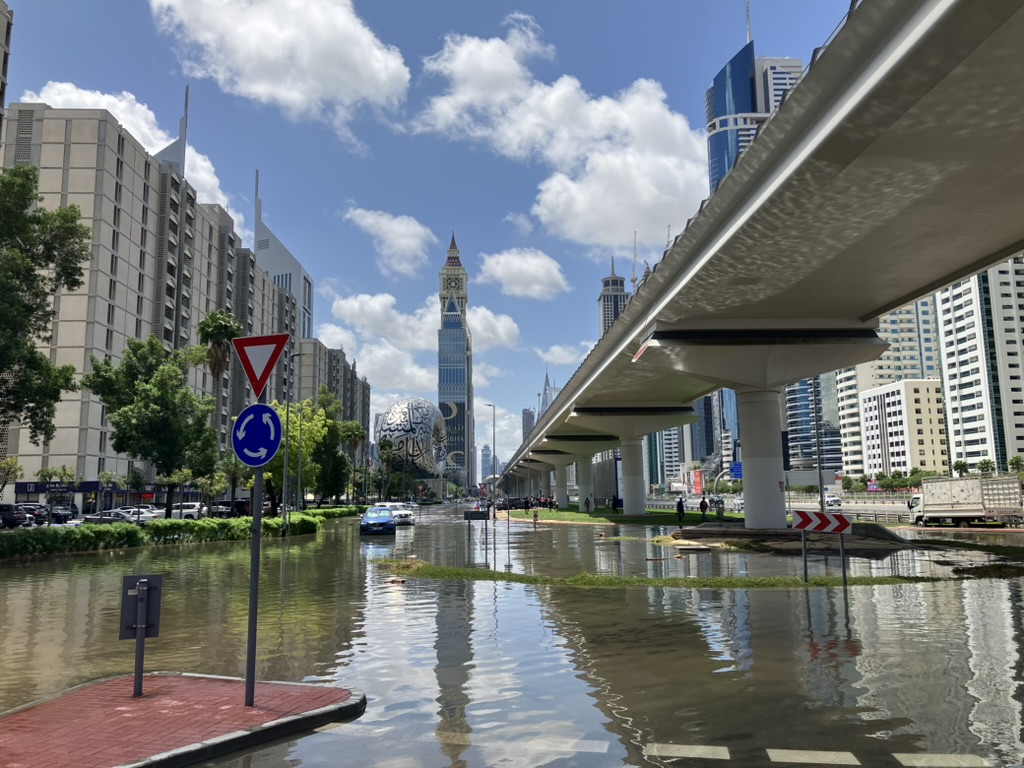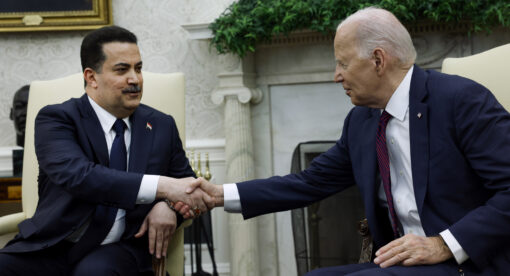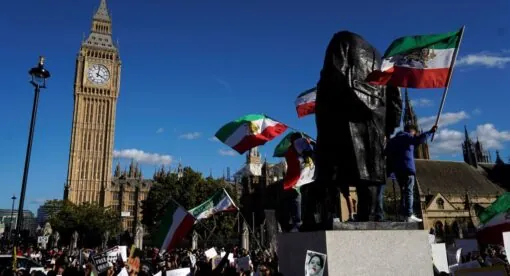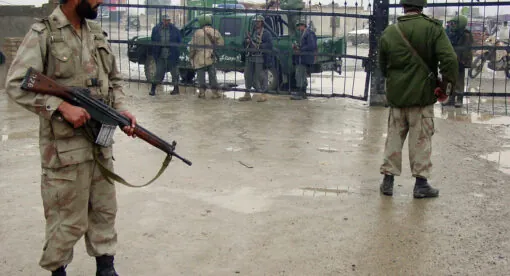In this episode of the Contours podcast, host Eugene Chausovsky talks with New Lines Senior Fellow Chaouki Ghenai about their experiences with the recent flooding in Dubai. They also discuss steps the UAE and wider world can take to adapt to the changing global climate and mitigate its effects.
Eugene Chausovsky:
Hello everyone, and thank you for joining us for the New Lines Institute for Strategy and Policy Contours podcast series. I’m your host for today, Eugene Chausovsky, and I’ll be talking to Chaouki Ghenai, our non-resident senior fellow for energy strategy and policy, about some unprecedented weather dynamics and the impacts of climate change we’ve been witnessing in places like Dubai, the United Arab Emirates, and other important cities and regions around the world.
In addition to his role at New Lines, Chaouki is a professor at the Sustainable and Renewable Energy Engineering Department at the University of Sharjah in the UAE and the coordinator of the Sustainable Energy Development Research Group at the Research Institute of Science and Engineering. Chaouki is also chair of the Energy and Climate Change Sustainability Office at the university.
Welcome back to the show, Chaouki. So, I recently visited Dubai, which is close to where you live in the UAE, Chaouki, and which was supposed to be the site for the Middle East Energy Conference, which is one of the largest energy gatherings in the world. However, the conference ended up getting canceled due to an unprecedented weather event in the UAE, which included more rainfall in one day than the country typically receives in one year. And we also saw how this led to flooding throughout the country and some major infrastructure challenges in the city, including the temporary closure of the Dubai Airport, which is one of, if not, the largest airports in the world.
I was wondering, Chaouki, first of all, can you discuss what you see as the cause behind this weather event in the UAE? And maybe discuss also how it relates to the broader issues that we’ve been witnessing with climate change more generally.
Chaouki Ghenai:
Okay. Yeah, many thanks again and good morning everyone. Yes, it’s great to talk to you today about this unprecedented weather and climate change effect on Dubai, United Arab Emirates and Gulf Cooperation countries or GCC countries.
Yes, as you mentioned, we were supposed to attend this Middle East Energy Conference in Dubai World Trade Center in April 16-18, ’24. But unfortunately, because of this bad weather condition and heavy rain that happened in the UAE, the conference was canceled because most of the exhibitors and visitors cannot travel safely to the event due to this harsh weather condition.
So, I want to say something about this conference because it’s related to this climate change. The Middle East Energy Conference is the largest comprehensive energy event in the Middle East and Africa. 40,000 professionals were expected to present at this event, making it a remarkable moment for the energy business. Policymakers, government agencies, business professionals, and solution suppliers, all needed to be present at this event in order to plan for the future of energy at this period of rapid energy transformation in the course of the process of establishing a roadmap for achieving success through the energy and climate transition within the power sector. So, the conversation will have the objective of engaging leaders from the region and beyond with the intention of sharing their experience and ideas regarding the most effective techniques and strategies to tackle the energy and climate challenges.
Returning to the weather event in the UAE, what caused the two days of severe rain, and what happened during that time? The storm hit the United Arab Emirates and Oman bringing with it a record of rainfall. After making its initial impact on Oman, the storm continued to make its impact on the United Arab Emirates causing power outages and causing significant disruption to flights. The United Arab Emirates experienced unprecedented rainfall, which has caused flash flooding to close schools, roads, highways, and international airports. The rain that happens in the United Arab Emirates was described as a historic weather event. It was greater than anything that has been documented for the past 75 years or so.
So, what is the cause? Global warming and other forms of climate change are the primary drivers of the storms. The emission of greenhouse gases that are created by humans are causing a rise in the temperature and increased humidity. This opens the door to the possibility that storms and other forms of extreme weather may become more powerful. The global warming and climate change affect the environment, the economics, and societies globally. It’s a global issue. The global warming is the increase in the average temperature, surface temperature, caused by human activities like the burning of fossil fuel, deforestation, and industrial process, while climate change is a long-term change in the weather patterns and temperature worldwide.
The rise in extreme weather events including hurricanes, floods, drought, heat waves, and wildfires is one of the most concerning efforts of climate change. Communities, ecosystems, and economies can be devastated by this disaster. Global cooperation, sustainable development, and aggressive greenhouse gas emission reduction are needed to mitigate climate change. We have to start taking action to reduce these greenhouse gases, to reduce this impact on climate, and reduce the global warming. And we need the collaboration between the governments, industries, higher education institutions’ research centers for the research part, and also the community. All of them, they must work together to transition to clean energy for climate change mitigation.
Climate change mitigation, that means developing clean energy technologies will help to cut the greenhouse gas emission and this global warming. But at the same time, we need to take actions to prepare for and adjust to the current and the projected impact of climate change. So, this is what we call climate adaptation, which is also very important. Also, we need to work on conserving natural resources and also build climate resilience.
Eugene Chausovsky:
Great. Thanks so much, Chaouki. And we’ll get into some of those measures in terms of climate adaptation that you mentioned in just a little while. But going back a little bit, you mentioned basically how global warming, the greenhouse gas emissions, these are the general causes, the general effects of climate change, which can cause weather events like this. I know there’s also been some discussion or even some speculation that in this particular case in the UAE, and I know in some other countries in the region, that perhaps that cloud seeding or the artificial use of rainfall was one of the reasons behind this. What do you think about that theory, so to speak?
Chaouki Ghenai:
Yes, that’s true. I think global warming is the main driver for this change in the climate and also the increase of the temperature. Yes, there is some speculation about rain seeding techniques that are used in United Arab Emirates, but I don’t think the main reason should be the climate change, because this kind of technique for the rain enhancement, it will help to get rain, but it will not help to get this kind of storm.
But what are the impacts now of this weather on climate change? I think with respect to the economical, social, and political impact, immediate physical damages to infrastructure in the ecosystem is only one aspect of the implication of this climate change-related disaster. But the effect extends well beyond that. They have significant repercussions on the social, economical, and political front, and they have the potential to worsen inequalities and vulnerabilities that already exist.
We give you just an example about economical impact, because it’s related to infrastructure damages. Disasters can damage roads, buildings, power lines, and other infrastructure disrupting the transportation, communication, utilities, and economic activities. It has a direct impact on the economical activities for the countries or the city. And there is also an increased cost related to the disasters. The disaster response, the recovery, and the rebuilding costs are rising, diverting resources from other development goals.
I will just give you some examples. According to the climate change studies recently, climate change-related disaster will create huge economical damages within the next 25 (years), because we are going to see more of this climate change-related disaster in the future. So, the damages are four to six times greater than the additional cost for mitigation, because we have climate change mitigation and now climate adaptations. Now you have the disaster, you have this flooding here, and this will cost also money.
So, the cost of climate adaptation is more than the cost of climate adaptation. I’ll just give you some numbers, some statistics. What happened here, I think, in UAE, the UAE government has created a fund, about $540 million. This is a flood relief fund to help the people or the families that were affected by the floods. But the economical impact of losses in UAE and Oman remains unknown, because you need some time to assess all the damages. As you know, also, Dubai economy relies on the tourism. Major disruption across multiple sectors can be affected due to this climate change-related disasters.
And other statistics, if you look in United States, for example, in 2023, United States had a record of $28 billion for the weather and climate disasters. This is a rising trend in frequency, the number of disasters that we get. For example, in ’23, it was increasing. We got the records. And also, there is a record of the cost associated with that.
So, the rising global warming and the growing number of people, homes, and companies in at-risk places are causing billions of dollars for the disasters. What happened here in the Gulf countries, the floods are part of the global trend. If you look, the economical effects of climate change are significant. In 2021, for example, the extreme weather condition at the global level cost $360 billion in losses. This represents 0.4% of the global GDP worldwide. There is a huge impact on the economy of this country due to this climate change disaster, so we have to take actions for climate mitigation to reduce the greenhouse gas emissions and also we have to be prepared and we have to develop also climate adaptation strategy.
This is with the economy, but there is also an impact for the social impact. Human health, for example, climate disaster can directly or indirectly cause injuries, disease, and death. Displacement of people, disaster can force individuals to flee their homes permanently or temporarily. There is also psychological and emotional impact from these disasters.
We’ll give you an example. For example, what happened here in April in the GCC countries, for Oman, for example, the recent strong rains in Oman caused serious flooding and about 18 deaths for Oman. And after making its initial impact on Oman, the storm continued its impact on United Arab Emirates causing power outages and causing significant disruption to flights, and runways were transformed into rivers. So, the storm system in UAE generated also flash flooding that closed schools, roads, highways, international airport. One, also, problem, some of the places, we saw that there is an absence of a drainage system. This is another factor that contributed to the prevalence of flash flooding.
Future challenges should include integration of climate engineering with urban developments. You go with the urban development, but you have to take into account this climate change disaster that can happen in the future. Warnings were issued by the government here in UAE in response to this severe rainfall asking, for example, an employee to work from home and to leave only in cases of critical necessity to go outside. Everyone should work from home. So, all the federal employees have been instructed to perform their job, for example, from a remote location.
For example, you have in here during this time at Dubai International Airport, activities were temporarily halted, and they canceled several flights. What we need here, we need a comprehensive catastrophic risk reduction. Climate adaptation, which is very important, sustainable development policies are needed to address all these social, economic, and political implications.
Eugene Chausovsky:
Thanks so much, Chaouki. Yeah, just as a brief anecdote on some of those impacts that you mentioned on the economic side, and even translating to the social, while I was there in Dubai in the middle of April, the weather event itself was only about a day or two, but it was several days afterwards where not only we saw temporary closures of the Dubai Airport, but all transportation arteries essentially of the entire city, whether that be the metro, whether that be buses, and even taxis and Ubers, were very limited, in some cases not available at all, which obviously has impact on mobility within the city but also its resultant economic and social impacts as well. This, I think, is a very important warning sign, something that Dubai and the UAE hadn’t experienced before. Hopefully, this experience can offer some lessons learned for the country.
And speaking of lessons learned, going beyond Dubai and the UAE and all of the different impacts that you’ve mentioned, what would you say are some lessons that we can take away from this situation for the global climate transition and how countries react to it? I’m thinking about we’ve seen, developments just in the past week or so, with flooding happening in Brazil, a similar situation happening in places like Texas in the U.S. And we’ve seen how that can lead to not only the weather events but also leading to deaths, to power outages, into transportation and infrastructure challenges. So, what do you take away from the experience that you’ve faced in the UAE and how you can apply that more broadly?
Chaouki Ghenai:
Yes. I think the lessons learned from this situation that happened here in UAE and also some of the GCC countries for the global climate transition and what are the challenges, I think some of the lessons learned, the first one, is the economic and social impact. Climate change-related disasters have serious economic consequences in addition to human losses. What we need to do, more efforts are needed to tackle these challenges using both, as I said, climate mitigation and climate adaptation. We have to work on both of them.
During the COP 28, for example, for climate mitigation, they put one of the outcomes is to triple, for example, renewable production by 2030. Increasing the integration of renewable, this will help to cut the greenhouse gas emissions. Another outcome during the COP 28 here in Dubai, UAE was to improve the efficiency of the energy system. These are some examples that we need to use to tackle this problem of climate change, of global warming, because we need to reduce the greenhouse gas emissions.
But at the same time, we have to work also on climate adaptation. The second, maybe, lesson is embrace adaptability and resilience. Countries and community have a responsibility to develop adaptation solutions. You need to have a plan for adaptation and put those ideas into action in order to respond to the repercussions of climate change both now and also in the future.
Another lesson is you have to develop a plan ahead for the extreme weather conditions. This will include, for example, what are the evacuation routes, family and emergency response, communication plan? Prepare an emergency kit, for example, with water, food, first aid, and flashlight. These are important during this kind of disaster. Improve the response to flooding and lessen the long-term damages to residents and infrastructure ecosystem by implementing, for example, mitigation and adaptation strategies.
In addition to immediate recovery, each country needs to reassess the infrastructure resilience to climate change. This is very important also. The recent rainfall in UAE and Oman and its aftermath will serve as a wake-up call demonstrating that each country is susceptible to this instability that nature can cause. What we need to do, reassessing the risk, recovering quickly, and constructing more resilient cities are priorities now. We have to take this seriously. In spite of the difficulties that are brought about by the climate change, we have the ability to construct the future in which infrastructure is able to sustain successful economies, a healthy ecosystem, and happy communities.
Eugene Chausovsky:
Great. Thanks so much, Chaouki. Yeah, you mentioned something really interesting earlier where the damages from this destruction and the disruption from these types of weather events can be four to six times the cost of the climate adaptation that you mentioned. So, there’s a real concrete economic impact, but also it goes beyond that. Things like reassessing infrastructure resilience and risk, I think, is really important.
Essentially, the way that I see it is you can be proactive versus being reactive, right? And the UAE was in the unfortunate position that this was something that hadn’t happened before, so it’s difficult to anticipate that specific type of weather event. But generally speaking, having a plan of action, of being able to work proactively to address that, I think, is not only better for the climate transition, but also it makes dollars and sense, so to speak, as well.
Because you’ve already touched on a lot of the different policy recommendations that you would make, not only in the UAE, but also in countries globally, because this is a global issue, I’m wondering maybe if you could just speak a little bit as we wrap up here on some places that you think are especially vulnerable and the measures that those countries, regions, or even cities can take, again, learning from the lesson that UAE and Dubai in particular just experienced.
Chaouki Ghenai:
Yes, thank you. Yes, some recommendations to address these challenges, these climate change challenges, is maybe the first one is development of a comprehensive approach, including both climate mitigation and adaptation. We have to work on both of them. Both of them are important. Future management of high rainfall and extreme weather conditions will benefit from a comprehensive approach customized to the region difficulties and future.
The first thing maybe is to implement an early warning system. Advanced monitoring and early warning system can identify and predict extreme weather events, giving evacuation and emergency preparedness time. The second one is related to risk assessment. The government should conduct a threat and hazards identification or risk assessment to determine what natural threats or hazards may affect their communities, their civilities, and their capabilities. Another recommendation is reliable communication. Communication is very important. The government must inform employees and people before, during, and after a severe weather disaster. Building a communication system for public safety is crucial. System availability, messaging, broad and targeted audience security and compliances for sudden prevention and flexibilities are required.
Another recommendation is install and maintain appropriate drainage system to prevent water collection and flooding during strong rainfall occurrence. Install, for example, rainwater harvesting devices, the retention pumps, and permeable surfaces to reduce the rainfall and improve water infiltration. Building robust infrastructure that can endure extreme weather is essential also. Infrastructure planning and development should include climate risk assessment to identify vulnerabilities and prioritize adaptation solutions. Develop climate resilience into cities. This is very important also. Design and develop structure and transportation system that can endure high rains and flooding. Implement environmental regulation and assessment. All the significant projects must undergo environmental impact assessment, including the flood risk evaluation that require mitigation solutions. Research and development and international collaboration is also important.
We need to put funds, regional funds for climate change research, see what we can do for climate change mitigation. For example, we need to put more funding to develop new technologies for clean energy technology like renewable energy technology, nuclear power, carbon capture utilization and storage, energy efficiency, electrification for industrial sector, transportation, buildings, development of low- and zero-carbon fuel that will help to reduce the carbon footprint, for example, green hydrogen, green ammonia. Afforestation and reforestation also is important. Developing new type of materials like the biochar or soil carbon sequestration that will capture the CO₂. These are some examples about climate change mitigation techniques that need to be developed in the future.
We need also some recommendation and awareness programs. Community resilience to severe weather requires consideration. The government should teach community members about the local risk emergency, the alert system, the emergency preparedness, where to get supports before, during, and after a catastrophic incident.
In summary, what I can say, it’s possible for the government, organizations, and individuals to effectively confront the problems posed by the climate change-related disaster and to construct societies that are more resilient and sustainable for future generations if they adopt this type of recommendation in a coordinated and integrated manner.
Eugene Chausovsky:
Great. Thanks so much, Chaouki. Yeah, I think just to wrap up, I think it was very interesting and even perhaps ironic that this Middle East Energy Conference that you and I were both supposed to attend, which is as we discussed, one of the largest gatherings in the world to talk about the climate transition, was actually disrupted by a climate event in a very real way. So, that just goes to show how difficult the challenge is and one that’s only growing, and how important it is to take all of the measures that you’ve outlined in terms of not only mitigation but also adaptation and going through with the climate transition that’s currently underway.
Unfortunately, we’re going to have to end it there, but I just wanted to say thank you very much to Chaouki for joining us. Thank you all for listening. Please feel free to visit newlinesinstitute.org for more analysis on energy and the climate transition. And everybody take care of yourselves. Bye-bye.








